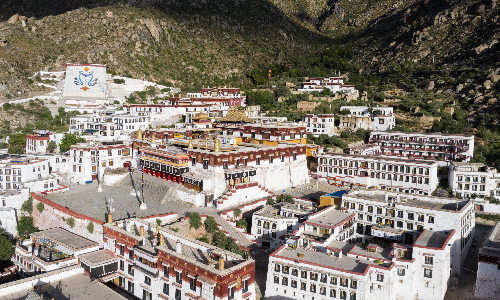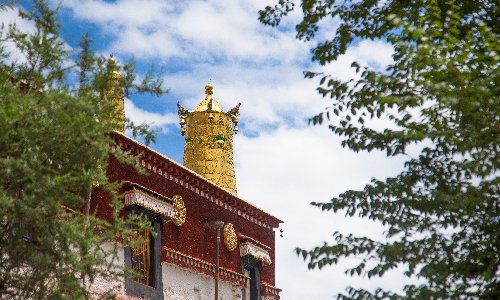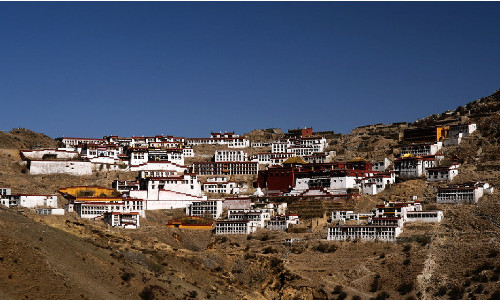Tibet, as the center of Tibetan Buddhism, is the holy place for countless pilgrims. Have you ever visited Tibet? Have you seen the sacred Potala Palace? Have you rolled the prayer wheels? If your answer is no, you should not miss this 5 days China Tibet tour. We will take you to Lhasa, the most typical Tibetan city and you will have the chance to visit several famous Tibetan temples and monasteries such as Jokhang Temple, Sera Monastery, Drepung Monastery, and so on. I am sure you will be amazed by the beautiful murals, vivid Buddha statues, and interesting Buddhist stories. And if you happen to meet the Buddhist festivals, you will enjoy the grand ceremony. Don’t hesitate to join this China Lhasa tour with monasteries.

Welcome to Lhasa! Your private guide will pick you up at the airport and escort you to the hotel. Lhasa is located at a high-altitude place. You are suggested to have a good rest after the long journey. You also need to drink more water, have more vegetables and fruits to alleviate high altitude sickness. Remember, eating less at meals can also help.
Situated in the center area of Qinghai-Tibet Plateau at an altitude of 3,650 meters, Lhasa is the political, economic, cultural, and educational center of Tibet and a sacred place of Tibetan Buddhism. It is honored as “the city of sunlight” as the annual sunshine duration of the city is always longer than 3,000 hours. Thanks to its picturesque natural scenery, unique culture, and snacks, it has become an ideal tourist destination for many people at home and abroad.
After breakfast, you will visit the Potala Palace, which is located on a mountain in west Lhasa. It is a palace-castle-style building complex built for Princess Wencheng in the Tang Dynasty (618 - 907). In 640, the king of Tibet, Songtsen Gampo, dispatched envoys to Chang’an, the capital of the Tang Dynasty, to request permission to marry a Tang princess. At that time, for the Tang Dynasty, it was a good way to make peace with rulers of minority nationalities by marriage. The next year, Songtsen Gampo was allowed to marry Princess Wencheng so he built Potala Palace with 1,000 rooms for her.
There are some rules for visiting this religious building complex. Visitors should not wear hats or take photos inside the Potala Palace and should not step on thresholds in the palace.
Lunch will be arranged in a local restaurant. In the afternoon, you will go to the Jokhang Temple and Barkhor Street. Besides Princess Wencheng, Songtsen Gampo married another princess from Nepal whose name is Chizun. Both of these two princesses brought a sculpture of Buddha to Tibet. Since they were the first two Buddha Statues in Tibet, Songtsen Gampo ordered to build the Jokhang Temple and the Ramoche Temple to enshrine them.
When you step into the Jokhang Temple, the first thing you will see is two stone tablets protected by fences showing the sincerity to keep a friendly relationship between Tibet and Tang Dynasty. There is a willow tree beside the stone tablets which is believed to be planted by Princess Wencheng, and therefore people named it the “Princess Willow”. Legend has it that the temple was built after filling a lake. And at that time, it was a group of goats that carried the sand and soil to the lake. Therefore, if you pay attention to the left corner of Maitreya Buddha Hall, you will find a small stone goat statue that is in memory of the contribution of the goats.
Upon the completion of the Jokhang Temple, it attracted many pilgrims and thus a path around it was formed. That is the original Barkhor Street. After the 15th century, when the Jokhang Temple became a center to spread Buddhism, dormitories for Buddhists, religious schools, and small temples appeared, and many Buddhists moved and settled here, bringing houses, stores, hotels, manual workshops.
Barkhor Street keeps the original style of the ancient Lhasa city: the street is paved by hand-polished stones and old-style Tibetan buildings are still reserved beside the street. Now, it becomes a prosperous street with more than 120 stores selling all kinds of religious articles, daily necessities, handicrafts, antiques, as well as Tibetan specialties and goods. What is more, you can also find goods from India, Nepal, Burma, and other countries.

After having breakfast at the hotel, your guide will pick you up and go to Norbulingka, a typical Tibetan-style garden covering an area of 360,000 square meters. There are more than 100 kinds of plants in Norbulingka, including common plants in Lhasa, rare flowers and herbs from the foot of the Himalayas, and precious flowers transplanted from other parts of China and other countries.
Norbulingka is an activity center during Sho Dun Festival, an important festival in Tibet. Every year in the evening before the festival, Tibetans will pitch tents near Norbulingka, wear traditional festival costumes, and sit around with families and friends, eating, drinking, singing, and dancing. When Tibetan Opera performances begin, they will sit in circles and appreciate the wonderful shows. Only during this festival, Norbulingka will be free of charge and some entertainment activities will also be provided for visitors.
Then you will visit the Drepung Monastery. Since it covers a large area with white buildings dotted on the hillside and looks like a huge rice heap in the distance, people called it the Drepung Monastery, which means “rice heap monastery” and symbolizes prosperity in Tibetan. When the Sho Dun Festival comes, the monastery will exhibit a huge Thangka of Buddha on the hillside, attracting plenty of believers and tourists. At the end of this festival, Tibetan people will serve the monks in Drepung Monastery milk and yogurt for celebration.
After lunch, your guide will lead you to the Sera Monastery. Thousands of Buddha sculptures made in Tibet or from the other parts of China and India are preserved in the monastery. you can also enjoy a large number of murals here. It is interesting that since both of the pronunciations of hailstorm and multiflora rose in the Tibetan language are “sera”, there are two versions about how the monastery got its name: one is that there was a heavy hailstorm during its construction, and the other is that the monastery was built in a place where multiflora roses were blooming.
Vajra Pestle Blessing Festival is a distinctive festival celebrated in the Sera Monastery. An old story goes that at the end of the 15th century, monks in Sera Monastery got and enshrined a vajra pestle from India on December 27 of the Tibetan calendar. Therefore, they hold the festival to pray for the blessings of the Buddha.


 Dagzê (At an altitude from 3,670 to 5,548 meters)
Dagzê (At an altitude from 3,670 to 5,548 meters) After you have your breakfast at the hotel, your guide will pick you up and drive for about 40 minutes to Dagzê, a district about 20 kilometers away from Lhasa in the northeast.
The most famous tourist attraction in Dagzê is the Ganden Monastery. It was built in 1409 by Tsongkhapa, the founder of the Gelug Sect of Tibetan Buddhism, and was situated 40 kilometers away from Lhasa in the east.
Every October 25 on the Tibetan calendar is the death anniversary of Tsongkhapa. A Buddha image with a length of 26 meters and a width of 10 meters will be shown to visitors during the daytime, and all the lights in the monastery will be lighted up at night to express their worship. Because of its grand ceremony, it has become the most important traditional festival in the Ganden Monastery.
After sightseeing in the Ganden Monastery, your guide will drive you back to Lhasa. Your lunch will be arranged in a local restaurant in Lhasa city. In the afternoon, you can arrange activities by yourself.


Say goodbye to Lhasa! Your guide will pick you up at the hotel and drive you to the airport according to your schedule. Hope we can serve you again in the future.
Author: Qiyue Hou
Proofreader: Betsy He
| City | Five Star hotel list | Four Star hotel list |
|---|---|---|
| Lhasa | Shangri-La Hotel, Lhasa | Thangka hotel |
 |
![]() About your child or infant, please contact us for a discounted price.
About your child or infant, please contact us for a discounted price.



We started with a few days in Beijing & ended in Shanghai, from where we visited the Forbidden City and Great Wall. In between we visited Terra Cotta Warriors Museum, Panda Base, Shanghai Disneyland.

We had a wonderful holiday in China which will remain long in the memory. China is a breathtakingly beautiful country full of splendid temples and palaces, mountains and rivers, peaceful rural scenes and bustling shopping streets.
 QUICK ENQUIRY
QUICK ENQUIRY